


Paul Adrien Maurice Dirac
1902-1984



Paul Adrien Maurice Dirac
1902-1984
Born 1902, Bristol, England. B.Sc. in electrical engineering from Bristol University, 1918-21. Stayed at Bristol for work in Mathematics, 1921-23. Ph.D. in Physics at Cambridge University with R.H. Fowler, 1923-26, dissertation on quantum mechanics. Research fellow at Copenhagen, Göttingen, 1926-27. Elected Fellow of St. John's College, Cambridge, 1927, Appointed University Lecturer at Cambridge, 1929. Visiting professor, UW-Madison, 1929. Elected Fellow of the Royal Society, 1930. Lucasian Professor of Mathematics (Newton's chair), 1932-69. Nobel Prize in Physics in 1933 for the development of relativistic quantum mechanics. Prize shared with Schrödinger for his wave mechanics. Professor, Florida State University, 1971-84.
Introduced q numbers and the canonical commutation relations into quantum mechanics, 1925. Developed the transformation theory of quantum mechanics, 1926. Treated the problem of identical particles in quantum mechanics in 1926, gave the theoretical basis for the Bose-Einstein and Fermi (-Dirac) statistics developed earlier using the old quantum physics. Quantized the radiation field and treated spontaneous emission, absorption, and scattering of radiation, 1927. Developed the Dirac equation and the relativistic quantum mechanics of the electron, 1928. Published Principles of Quantum Mechanics, 1930. Theory of the positron, 1931. Investigated quantized magnetic monopoles, derived Dirac quantization condition relating electric and magnetic charges, 1931. Covariant approach to quantum field theory, 1932. Introduced the basic idea of the functional integral approach to quantum field theory, 1933. Worked on cosmology beginning in 1937. Fundamental work on constrained Hamiltonian systems, 1950, application to quantum gravity, 1958.
Some references to early papers are
"The fundamental equations of quantum mechanics", Proc. Roy. Soc. London A 111, 281 (1925).
(Introduction of canonical commutation relations.)
"The quantum theory of the emission and absorption of radiation", Proc. Roy. Soc. London A 114, 243 (1927).
(The beginning of quantum electrodynamics.)
"The quantum theory of the electron", Proc. Roy. Soc. London A 117, 610 (1928).
(Introduction of the Dirac equation.)
"The basis of statistical quantum physics", Proc. Cambridge Phil. Soc. 25, 62 (1929).
(Quantum mechanical basis of Bose-Einstein and Fermi-Dirac statistics.)
"Quantized sigularities in the electromagnetic field", Proc. Roy. Soc London 133, 60 (1931).
(Magnetic monopoles, quantization of electric charge.)
"The Lagrangian in quantum mechanics", Phys. Zeit. Sowjetunion 3, #1 (1933).
(Basis of the path integral in quantum theory.)
For a nice summary of Dirac's impact, see R. Dalitz, Paul Dirac: a genius in the history of physics, CERN Courier, September, 2002.